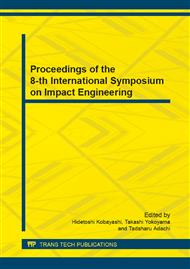p.338
p.344
p.353
p.359
p.365
p.371
p.379
p.385
p.391
Projectile Mass Loss Model Using the Coefficient of Friction for High-Speed Penetration into Concrete
Abstract:
In this paper, a model of the friction coefficient in the high-speed penetration process has been used, which considers the micro-asperities of the projectile surface, the adiabatic shearing and the heat conduction on the nose of projectile. It also considers that the coefficient of friction is a function of the sliding velocity. Then, an analytical model of mass loss based on the coefficient of friction and the revised dynamic spherical cavity expansion theory of the concrete material is constructed. An analytical estimate for the work done by friction force in the penetration could be calculated and the evaluation of mass loss of projectile could also be calculated by the heat translated from the work done by friction force. Finally, a comparative analysis between the calculated data and the experimental data of mass loss is done.
Info:
Periodical:
Pages:
365-370
Citation:
Online since:
June 2014
Authors:
Price:
Сopyright:
© 2014 Trans Tech Publications Ltd. All Rights Reserved
Share:
Citation:


